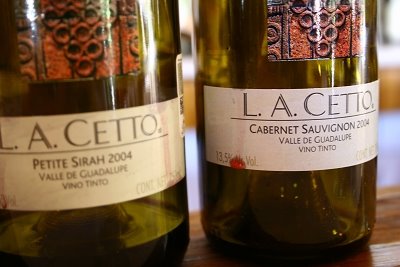Laja is a quaint restaurant in Baja California featuring pristine local, seasonal ingredients, located about 10 miles north of Ensenada in the heart of the wine country of Guadalupe Valley...
Wait a second! Wine country in Mexico? That's right. Mexico was actually home to the first vineyard plantings in North America; the cultivation of wine grapes began over 400 years ago, and the region has seen a real renaissance of serious wine-making efforts over the past decade.
Good food and wine? That was all we needed to hear to rent a car and cross the border.

With all the information on the internet, there is a surprising dearth of commentary about travel and road conditions for Mexico’s highways. We had no idea how long the trip would take in its entirety, with the biggest question mark being the potential for an excruciating 3+ hour wait to cross back into the U.S. at San Ysidro. We decided to optimistically aim for this schedule:
- 9 am: Leave San Diego for Tijuana; head for Ensenada on Route 1
- 11 am: Arrive in wine country and visit L.A. Cetto, Monte Xanic, and Chateau Camou
- 1:30 pm: Lunch at Laja (their earliest reservation)
- 6 pm: Cross the border at Tecate via Route 3 (2 lane highway)
- 7 pm: Return the rental car in San Diego and catch our 8:15 pm flight back to Oakland
Could it be done? With only 2 hours allotted to get to Tecate and wait through the line at the border, it seemed like a 50/50 chance we’d miss our flight.

The border crossing into Mexico was ridiculously easy. There’s no checkpoint; you just drive on through as if you’re driving into Nevada. Of course, within 47 seconds of crossing the border, we missed our exit and were lost for about 5 minutes in the outskirts of Tijuana. Nice move. Somehow, Lav pointed us back onto the right freeway (you’d think that following a numbered highway would be easier), and we got back on track. The coastal drive on Route 1 is pretty nice, with some spectacular views that are reminiscent of driving Highway 1 in California.

The rest of the ride was smooth sailing, with just three quick toll crossings along the way. The roads are in great condition, and it basically felt like driving in the U.S., but with lower speed limits (I’d read too many warnings about getting stopped for speeding by the Mexican police to test the speed limit). About 5 km north of Ensenada, we veered northeast onto Route 3 and were soon greeted with this glorious sign. Roughly translated, to me it said “Good things await ahead.”

The wine country in Mexico is like a mellowed out version of early Sonoma… small wineries along the ruta del vino, unspoiled and uncluttered by the madness of weekend tourists. Our first stop was L.A. Cetto, Mexico’s largest wine producer (www.cettowines.com), which is actually located at the northern-most end of the wine road, near the 73 km marker.

We sampled their Chardonnay, Sauvignon Blanc, Petite Sirah and Cabernet Sauvignon… pretty interesting how the climate here can accommodate quite a wide array of varietals.

More than the wines here, we were drawn to the extra virgin olive oil made from the winery’s estate-grown olives. Smooth and rich, with very low acidity and only a faint herbaceous note, Cetto’s olive oil is remarkably tasty stuff.

As we headed off to the next winery, we couldn’t help but notice how similar the landscape is to our own wine country. It really is beautiful and peaceful here.

We backtracked on Route 3 and arrived at Monte Xanic (www.montexanic.com), a facility tucked into the hillside. As their website explains, “Xanic” is a native Cora Indian word meaning “the flower that blooms after the first rains.” A fitting name for a winery making some special wines.

From the parking lot, we entered through a beautiful arched wood door, which led directly into one of the barrel storage rooms.

We had the opportunity to taste 11 different wines while sampling their estate-grown olives. The quality of these wines across the board was quite high. The most interesting aspect for me was observing the differences in vinification styles here, mostly in the white wines. The chardonnays tend to have substantial oak (although the winery also makes a completely un-oaked chardonnay as well). The sauvignon blanc is completely different; much more tart and citric, and with a hint of underlying savory/vegetal character... but with oak as well. As Ezrael, one of the managers of the winery explained, they are still experimenting with which varietals will thrive in the valley.

This is Jose, our new friend who was hooking us up in the tasting room. Chenin Blanc reportedly does very well in the Guadalupe Valley, which makes sense, since it can thrive in warmer climates than most other grapes. Monte Xanic’s version exhibits a tropical, Viognier-like nose of papaya and stone fruit, opening up to a simple, but delicious palate of honey, peaches and lemon rind. They blend in 5% Colombard, which adds a unique element of acidity not typically found in Chenin Blanc. Ezrael came by and gave us a special taste of their single varietal Malbec (which the owner had opened earlier for some friends) which was excellent. Dark and brooding, the Malbec had a firm core of dark fruit and plum, a luscious mouth feel and a medium-long finish evoking just a hint of earthy spice at the end (fennel seed?). Really, really nice.
We were having such a good time at Monte Xanic that it was 1:30 pm before we knew it… so we had to skip the well-regarded wines of Chateau Camou, which was just up the road. That’s alright; that just gives us another place to try next time. It was time to eat.
No comments:
Post a Comment